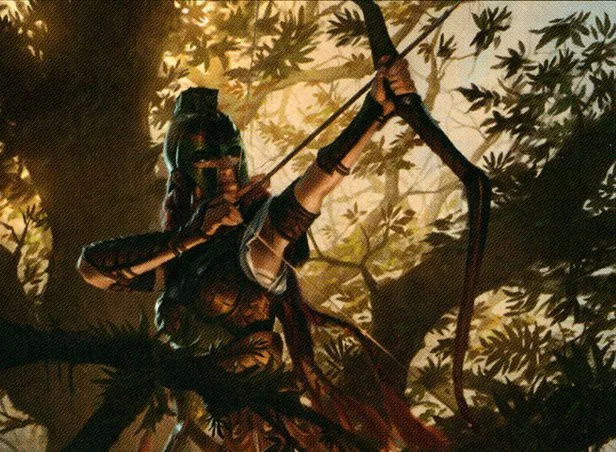Sharpshooter 5e
Published on March 12, 2022, Last modified on May 24th, 2022

Slawomir Maniak - Wizards of the Coast - Bassara Tower Archer
Arcane Eye may earn a small commission from affiliate links in this article.
Learn more.What Is Sharpshooter 5e?
Bows are a longtime mainstay in any fantasy setting, with the iconic imagery of mighty longbows held by beautiful elven creatures, or dastardly foes with short bows. In D&D, these are even more common since so many creatures prefer bows to other ranged weapons.
One of the more fun parts of playing a ranged character is the ability to hit targets under crazy circumstances. And luckily enough, there’s a feat that allows you to do just that: Sharpshooter!
How Does Sharpshooter Work?
If you pick up this feat, you get three brand new features for your character:
- Your ranged weapons will now ignore half cover, and three-quarters cover.
- If you make an attack at long range, you no longer get disadvantage on the attack roll.
- When you make an attack roll with a ranged weapon, you can choose to subtract five from the attack roll, and if you hit, you deal +10 damage.
Of course, these benefits apply to any ranged weapon, meaning you can get pretty creative than just using a bow (darts anyone?).
Is Sharpshooter Good?
We gave Sharpshooter an S Tier rating In our 5e Feats Tier List, making it among the most potent feats in D&D 5e.
Attacking at long range without disadvantage and ignoring cover is great for any ranged builds. Throw in the same ability from Great Weapon Master (GWM) and take a -5 on your roll to do +10 damage and you have an amazing feat.
This ability is usually even more viable than GWM because of the Archery fighting style, which is available to a number of builds. Granting an automatic +2 to all attack rolls with ranged weapons enables builds to utilize Sharpshooter’s -5 ability at much earlier levels and with more reliability than GWM.
Sharpshooter 5e Interactions
Naturally, there are a few fun caveats to using this feat. However, I couldn’t find a lot of interactions with this particular feat, aside from a rules interpretation: Thrown weapons (daggers, spears, handaxes) can work. This isn’t accurate according to the Rules As Written (RAW) but was confirmed by Mike Mearls.
Which 5e Classes Make the Most of Sharpshooter?
The color code below has been implemented to help you identify, at a glance, how good the Sharpshooter 5e feat is for a specific class/subclass.
- Red isn’t going to contribute to the effectiveness of your character build at all
- Orange Situationally good, but a below-average option otherwise
- Green is a good option
- Blue is a great option, you should strongly consider this option for your character
- Sky Blue is an amazing option. If you do not take this option your character would not be optimized
Artificer: The damage boost and ability to ignore cover from Sharpshooter make this a must-have if you are building a ranged artificer.
Barbarian: Barbarians aren’t one for ranged attacks, so they won’t gain anything from this.
Bard: Bards get a little use out of it with various ranged weapons. Sharpshooter offers a good damage option outside of spellcasting.
Cleric: Clerics that don't solely rely on spellcasting typically spec into a melee weapon build, rather than a ranged weapon build.
Druid: Druids absolutely don’t need this, as none of their class features are ranged weapon-focused.
Fighter: Pretty much the same thing as Great Weapon Master. The negative you take to your attack roll for damage can be offset a bit more by using the Archery Fighting style. This is an insanely good pickup for ranged, DEX-based fighters.
Monk: Most monks can ignore this feat, but those who pick up the Way of the Kensei can benefit from this, as they must choose a ranged weapon for one of their kensei weapons.
Paladin: Paladins don’t get any benefits from dealing ranged damage and would rather be up close and personal.
Ranger: Ranged attacking is already a very powerful mechanic. Sharpshooter provides a ton of extra versatility to ranged attacks and can net some huge damage, especially combined with the number of attacks Hunter rangers can get. Take this as soon as you max your DEX.
Rogue: If you’re playing as a ranged rogue, this is pretty much a must-have. The -5 penalty can be easily offset by attacking from unseen, which is what rogues excel at. The extra 10 damage and the ability to ignore half and three-quarters cover will make you an absolute nightmare on the battlefield when paired with your sneak attack.
Sorcerer: Sorcerers gain nothing from this feat, as they don’t typically ever rely on ranged weapon damage.
Warlock: Typical warlocks want nothing to do with Sharpshooter as their eldritch blast gives them all the ranged damage they could ever need. Hexblades, on the other hand, can make a ranged weapon-focused build work with Hex Warrior and Pact of the Blade's features and will need the Sharpshooter feat to output comparable damage to an eldritch blast build.
Wizard: Wizards gain nothing from this feat, as they don’t typically ever rely on ranged weapon damage.
Target Practice Is Over
Anyone who has dreams of being Legolas or Katniss Everdeen in their D&D games will want to pick this feat up. Sharpshooter can absolutely make certain subclasses shine, and it accentuates the fun of other character builds.
How do you feel about Sharpshooter? Is there an interaction you want to know about that we didn’t mention? Let us know in the comments!
Fill out the form below to receive Escape From Mt. Balefor for free!
Or follow us on Instagram, Twitter, and YouTube.

